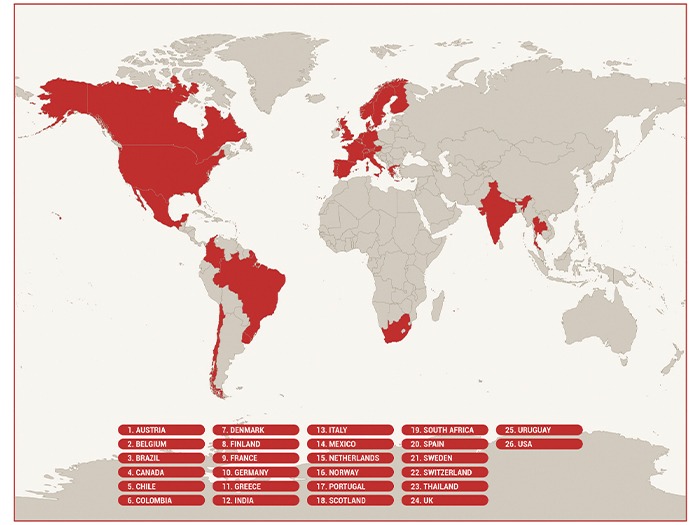
Follow the Light: Where to search for useful research information
Asst. Prof. Dr. Karolina M. Zielinska-Dabkowska IALD, IES, CIE, MSLL, RIBA, looks at the importance of research, and the best places for lighting designers to find this information.
Architectural Lighting Design (ALD) has never been a standalone professional discipline. Rather, it has existed as the combination of art and the science of light. Today, third generation lighting professionals are already creatively intertwining these fields, and the acceleration in scientific, technological and societal studies has only increased the need for reliable multidisciplinary information. Therefore, a thorough re-examination of all aspects of ALD and how it relates to those particular changes is an urgent necessity.
Further research is required to develop a new body of knowledge about ALD so that lighting professionals can improve their expertise in the field and receive better remuneration for their complex work. In the near future, we should be aiming for professional recognition as experts and join other recognised professions such as: architects, doctors, dentists, lawyers, engineers etc.
While lighting designers (LD) need to constantly update and re-examine their knowledge, they face two dilemmas. First, WHERE should they search to obtain useful information on lighting in related fields? And secondly, HOW should they successfully evaluate the viability of this information in a time of “Google-isation”, Wikipedia, “lobbying” and data manipulation.
In order to answer the above questions I undertook a research study in 2016 with French lighting designer Anne Bureau. More than 100 independent lighting designers, researchers, educators, journalists and manufacturers connected to the lighting field participated in an online lighting survey (Fig. 2). We wanted to understand where the profession stands in regards to research.
Participants from 26 countries around the world took part in the survey, with the majority from Europe and North America (Fig. 3).
The outcome of this investigation was presented at the IALD Enlighten Conference in Prague, Czech Republic. Unfortunately, this research was never published by IALD to a wider audience, (the conference format does not provide a publication of conference proceedings), hence the article in this issue of arc.
It is important to acknowledge this work included inputs from top independent lighting designers in the field who understand that research is vital and tightly connected to their day to day work. For instance, Mark Major, Principal at Speirs + Major believes that:
“Research is the life-blood of lighting design. Whether carried out as an integral part of a project or as an independent academic exercise, the thorough investigation of problems and opportunities through the evidence-based gathering of knowledge can lead to new creative thinking and more robust technical solutions. Not only can we learn from the past and the present by projecting our future visions and testing them, we can also ensure that our understanding of light and darkness constantly progresses.”

© by Anne Bureau & Karolina Zielinska-Dabkowska
Where to search?
Two distinct levels of understanding that determine the usefulness of research information have been identified:
1: basic level (“found” on the internet via googling, and the source is difficult to verify) and 2: advanced level (research that is provided by scientists or practitioners, which is often documented).
The main source of useful research information that can be applied in lighting design projects for the majority of participants is still print media (for example, peer reviewed publications, books and lighting magazines, newsletters and even student’s master theses) as well as internet media, while the younger generation tends to prefer to use Twitter, Pinterest, Instagram, Facebook, YouTube and Vimeo. Additionally, people attend live events and public talks related to light and lighting.
There was also an indication from survey participants that sometimes they are unable to find the information they are looking for. Often, they felt relevant data was either published by disreputable sources or simply it didn’t appear in searches. Moreover, the desired information was missing (not enough research has been done on this topic). Some people even believed it is difficult to find lighting specific research that reached a sufficient level of consistency for a specific topic. Sometimes information was unavailable due to open access restrictions, for example, some journals have restricted access to the free downloading of papers. Similarly, norms and regulations involve a charge or fee and the paper may be unavailable on the internet in digital format. This may mean a printed version needs to be ordered but it’s no longer available, or it takes time to deliver and/or it’s a costly process.
Also, two distinct levels of accessing/gaining knowledge have been identified. Firstly, with international, global reach, (e.g. conferences, international magazines), and secondly, with national or local reach, which is often country specific, (e.g. smaller seminar events and publications in the local language).
What to search for and how to evaluate information viability?
For more than 50% of participants, the most interesting topics seem to be interdisciplinary research connected to medicine, environment, biodiversity, biology, sociology, behavioural studies, culture, art, etc. as well as new developments in lighting technology, materials and tools.
As lighting practitioners are overwhelmed with information and there is not enough time to digest it all, the aspects of verifying content seems to be of enormous significance.
Based on a performed study, three methods have been identified. Firstly, participating in established events that provide CPD accreditation (e.g. http://bit.ly/35OmXMT, http://bit.ly/33CJOcG). Secondly, reading books and articles by established scientists and practitioners who share their knowledge (https://go.nature.com/2OBHcry, https://amzn.to/2P3iS0N, http://bit.ly/2Y768dE), and lastly, searching the websites of established universities, research institutions and organisations/associations (http://bit.ly/2Y768dE, http://bit.ly/37PkLqi, http://bit.ly/2OYQzAz).
It appears that few lighting designers would read through actual academic papers. Instead, most try to distill information from relatively commercial outlets that have translated academic text into a short summary or quotation. However, it is still unclear “how” lighting designers translate gained “knowledge” into their work. Gaining knowledge is one thing, what designers do with it is another – and their interpretations or translations of it are of interest and value, and need to be further investigated.

© by Anne Bureau & Karolina Zielinska-Dabkowska
To share or not to share?
There are two distinct levels of sharing knowledge:
1: information that is shared publicly (some general aspects in articles, such as talks at professional conferences or on company websites), and 2: information that is typically not shared (detailed internal knowledge that is shared only with respectable, trusted competitors. This knowledge provides unique insight and advantages, so it’s wise not to give it away to everyone). Some information is proprietary and kept confidential or it is limited to a small group of insiders.
Design driven by research
At the turn of the 21st century, when I joined the lighting design community, light was used as a medium to create mood and increase the appeal of places at night for visitors. The emphasis was on aesthetics. Lighting professionals relied on dramatic illumination effects to celebrate power and the significance of their clients and to make statements. At the time, the more visible light that was used, the better. Fortunately, the days are gone where floodlit towers that cause light pollution and an enormous negative environmental impact are given international awards. Back then, those in the lighting field couldn’t envision how rapidly the use of light would change, all thanks to transdisciplinary research and its available outcomes. Only ten years ago, a lecture given at Light Focus Euroluce Conference in Milan on What defines excellent lighting design for humans and animals was questioned and some people didn’t want to believe that the thoughtless use of light would have a detrimental impact on human beings, but also on the natural environment. Today, this is simply accepted as fact.
In my view, in recent years, we have matured as a profession by designing carefully thought through lighting projects, which take into consideration the impact of artificial lighting on humans, flora and fauna. This is also evident by the many conferences and seminars, and established quality lighting design Master’s programmes around Europe, US and Asia, as well as increased PhD interests in research topics related to light and lighting.
Catherine Perez Vega is one such person to have forged a new path. I first met Catherine in 2015. She was one of the international students under my tutelage at the Master’s Programme in the Architectural Lighting Design at Hochschule Wismar, Germany. Later, I supervised her Master’s thesis titled: The Environmental Impact of Lighting Design on Flora and Fauna, Recommendations for Lighting Designers. This work obtained the highest grade possible.
After her graduation in 2016, Catherine was chosen as one of four designers from around the world to present the results of her research during the Light Symposium Paper Competition 2016 (LSPC2016) at the Light Symposium Wismar 2016, and she was awarded first place. Later that day, she was approached by the organisers of the eighth edition of LEDForum in Sao Paolo, Brazil, and asked to be an opening speaker at that event. In order to continue her research on light pollution, ecophysiology and urban lighting design for sustainable lighting design applications, Catherine was offered a research opportunity in Germany by the Freie Universität Berlin (FUB) in collaboration with Leibniz-Institute of Freshwater Ecology and Inland Fisheries (IGB) and Hochschule Wismar. This unique doctoral project, called The Environmental Impact of Artificial Lighting in Urban Settings: Approaches for Sustainable Lighting Design is supervised by a team of scientists and practicing lighting designers that includes: Assoc. Prof. Dr. Franz Hölker, Prof. Dr. Jonathan Jeschke, Prof. Michael F. Rohde and myself. The aim is to create an interdisciplinary approach that provides guidance on relevant issues for lighting design practices, based on science that includes the impact of urban artificial lighting on flora and fauna and its contribution to light pollution. After the completion of her PhD studies, Catherine will be granted a doctorate degree in biology at FUB, one of the first of its kind in a subject related to lighting design, biology and light pollution. Catherine has completed her first year of research. The work produced so far will be published in an open access publication in the 2019 Sustainability Journal, and shared soon within the lighting community.
Due to climate change and the development of environmental and health state policies, the engagement with specialists in various fields, and the transfer of knowledge have now become a necessity. I predict the future of lighting design practices will involve positions for lighting designers and researchers like Catherine and other newcomers. There will also be more focus on individual responses and the needs for light and lighting dictated by age, gender and race to improve general health and wellbeing – all based on available research information.
The Takeaway
• It’s essential to provide a multidisciplinary approach outside normal design boundaries and to create solutions based on a new understanding of complex knowledge and new research.
• More ideas on how to bring interdisciplinary knowledge to the light and lighting field are required.
• We must reduce the knowledge sharing gap and improve the current culture of communication between knowledge/research creators and its users, e.g. lighting designers.
• It’s crucial for ALD that research as a form of systematic inquiry involves the practical application of science. Without a theoretical foundation tested in practice, there is no true profession.
•Lighting practitioners should provide more opportunities in their design practices for younger designers/scholars to work on research topics related to applied research in ALD.
• The design of a platform to exchange and share peer-reviewed and well administrated research information will be extremely useful, as not a single, respectable, contemporary and up-to-date database exists



